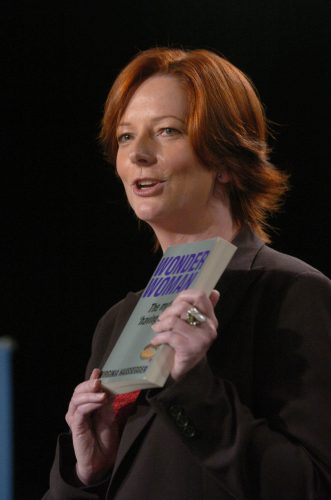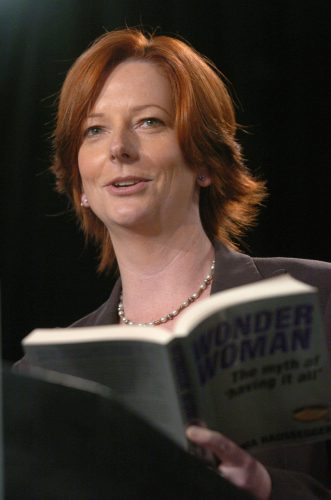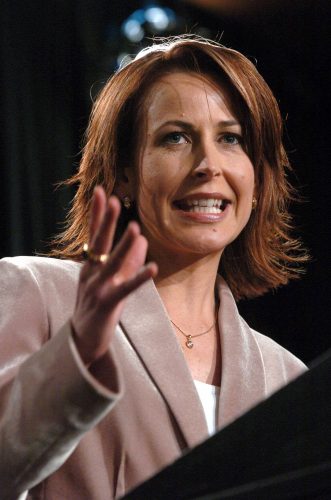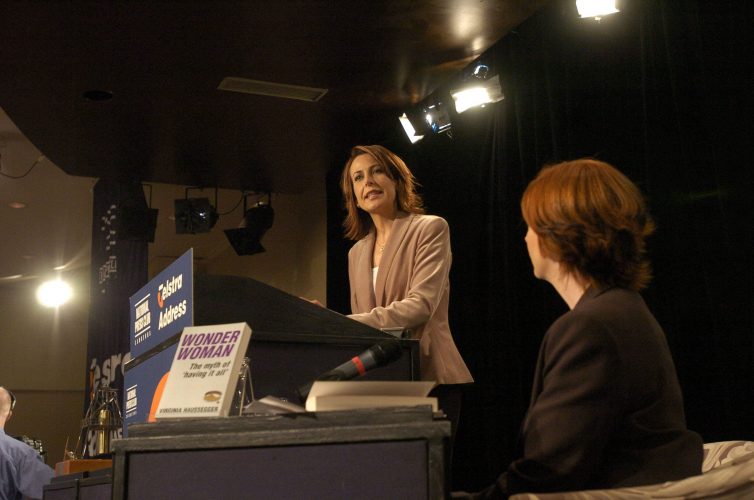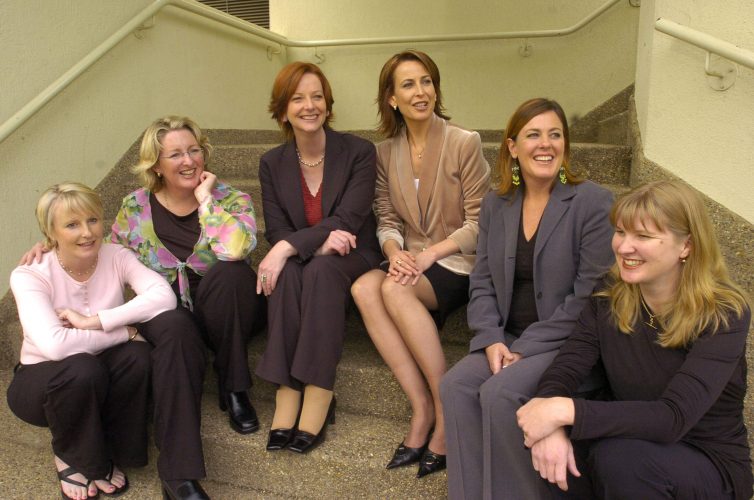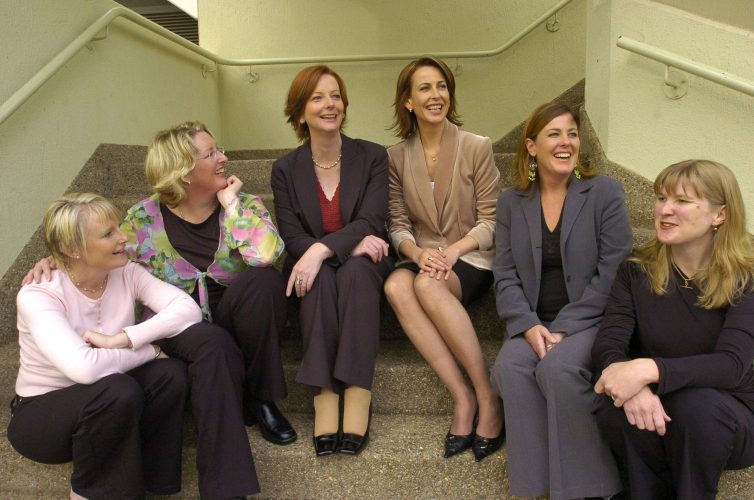A media bonanza for the shelias’
The Turnbull to Morrison years proved to be a bonanza for women in politics, for all the wrong reasons. What was once a sideline of political discourse – the representation and treatment of women – became the main game by late 2018, as a wounded government with a headline ‘woman problem’ schlepped towards what most pundits assumed would be certain electoral defeat. With increasing international interest in Australia’s “larrikin” and “aggressor” MPs “who thrive in the ‘rough-and-tumble’ atmosphere of Canberra”, the BBC pondered just days out from the 2019 election, “Why politics is toxic for Australia’s women”, highlighting how the nation had fallen down the global rankings for parliamentary gender diversity, from 15th two decades ago, to 50th in 2019.[1]
For those seated under that grassy knoll that covers the House on the Hill, the proverbial bullets from bullies were flying in all directions, and a growing cabal of courageous women MPs and Senators were refusing to duck for cover. But that didn’t stop them getting wacked. Some copped it and buttoned up, others doubled down. A couple turned on their heel and walked out of the party room, and Parliament.
For those of us on the outside looking in, this long overdue attention being paid to women in politics was both thrilling and nerve wracking: thrilling to see the stubbornly low proportion of women in federal politics finally attract public attention; but nerve wracking as the collateral damage – in female form – began to pile high. At times it was like watching a slow moving train-wreck. While Julia Gillard’s 2012 misogyny speech may have primed media hounds for the stench of sexism in the corridors of power, and the MeToo global juggernaut propelled that interest beyond occasional headlines, the gendered issues that came to define Australia’s 45th Parliament took on a life of their own.
The Liberal party’s exceptionally low number of women in parliament – 23 percent compared to Labor’s 46 percent – may have primed the public for a debate around women in power, but this new hyper-feminised focus transcended political allegiance. Slut-shaming, senator’s ‘shagging’, name calling, a world first ‘bonking-ban’, lurid details of female MPs and the absence of knickers, along with blatant sexist evaluations of women’s leadership capabilities – fuelled by a Royal Commission into Banking that fixated on the failings of female corporates leaders – all coalesced to make the Turnbull-Morrison administration a pressure cooker environment for women.
Although media gave more space and airtime than ever before to discussing ‘women in politics’ the framing around these issues did little to normalise a women’s right to take and exercise political power. Instead media characterisations of the barriers and obstacles to women’s progress as political players fell broadly into three constrictive archetypes: woman as precious ‘princess’ and weak ‘victim’ – who should “take a teaspoon of cement and toughen up” according to award winning radio broadcaster Alan Jones[2] ; woman as an immoral distraction to the important business of the day (Emma Husar and Sarah Hanson-Young); and woman in need of a ‘feminine realignment’ – that being either a return to nurturing and motherhood (as in the case of Kelly O’Dwyer and Kate Ellis), or seeking support of the ‘sisterhood’ (Julia Banks, Rebekha Sharkie, Kerryn Phelps) in order to avoid political isolation. No matter how the frame cropped the story, the women at the centre of it rarely transgressed beyond political oddity. Indeed the heightened media attention on women during the Turnbull to Morrison administration from 2016 to 2019 served to further entrench women in politics as isolated outsiders, still trying to ‘fit in’.
International Women’s Day bloopers
Prime Ministers invariably make foolish comments about women’s progress on International Women’s Day (IWD), as unreconstructed male chauvinism slips between the carefully crafted lines of speech writers. Such was the case on 8 March 2019, when Prime Minister Scott Morrison told a breakfast audience at a Chamber of Minerals and Energy event in Western Australia that “we want to see women rise, but we don’t want to see women rise only on the basis of others doing worse.” In what appeared to be an additional ad-lib moment the PM went on to say, “And we want to see the rise of women in this country be accelerated, to ensure the overall pace is maintained (sic).”[3] The somersault of contradiction in that latter comment – when the significant lack of ‘pace’ of women’s political and economic progress is why we mark International Women’s Day – seemed to have escaped Morrison. The subtext of his message was quickly interpreted as a covert defence of male privilege and the Prime Minister was forced to explain himself. [4]For a Government already plagued by controversy over allegations of sexism and bullying during the previous year’s leadership spill, these comments reminded the public that the Government’s ‘woman problem’ was more than just a number shortage.[5]
But Morrison is not alone when it comes to IWD bloopers. On 15 February 2018, fresh from an International Women’s Day Breakfast in support of UN Women and proudly sporting a purple IWD ribbon on his lapel, Prime Minister Malcolm Turnbull fronted a large media crowd in the parliamentary court yard. With stern face he announce the world’s first ‘bonking ban’, prohibiting Minister’s, married or single, from having sexual relations with their staff. His Deputy Prime Minister Barnaby Joyce’s affair with his advisor, Vikki Campion, had dominated headlines and water cooler conversation for weeks. As a conservative, outspoken National Party leader, Joyce had long made a political virtue of being a married father of four. He’d voted against the Prime Minister’s own position on marriage equality, insisting that marriage between a man and a woman “had stood the test of time”. Now as news broke that not only was Joyce living with Campion, but she was pregnant – although Joyce intimated he may not be the father – the Prime Minister was anxious to deflect what was fast becoming a salacious sex scandal[6]. As cameras flicked over to live-broadcast, the PM made an impassioned statement about Ministerial conduct, appropriate behaviour and how his heart went out to Joyce’s wife Natalie and their four daughters. “Barnaby made a shocking error of judgement in having an affair with a young woman working in this office,” he said, “in doing so he has set off a world of woe for those women and appalled all of us.”
As he spoke it was hard not to fixate on the bright IWD ribbon pinned on the PM’s dark suit. Catching the sunlight, it shone like a purple feminist beacon. I noted the ribbon for two reasons. As a former Board member of UN Women National Committee Australia, I was always pleased when male leaders wore our ribbons. But on this occasion the irony of seeing it brandished as the PM titillated the public with his extraordinary sex ban, while simultaneously stigmatising young female staffers – as the seductive source of a Minister’s downfall – was just too much. You could almost hear the weary sigh as Fairfax columnist Jacqueline Maley wrote in response to the bonking brouhaha, “Women pay the consequences for men’s failure and weaknesses far more often than the reverse is true.”[7]
Rather than take this opportunity to reopen what others had shelved and reintroduce the call for a parliamentary Code of Conduct, to enshrine ethical and behavioural practices for all federal politicians and staff, instead the proverbial finger began wagging at those ‘naughty’ young women who seduce their powerful bosses[8]. Less than a fortnight later the Minister for Jobs, Senator Michaelia Cash – a former Minister for Women – rammed that message home during a terse Senate Estimates hearing in which she attempted to deflect questions about the employment record of one of her staff in which she said “I am happy to sit here and name every young woman in Mr Shorten’s office over which rumours in this place abound” [9] Once again, the issue of women as agents of (immoral) distraction in what should be a (manly) place of democratic deliberation was the media story, rather than the heavily masculinised model of behaviour that continues to shape Australia’s parliamentary workplace.
Sexism, shagging and Sharon Stone
Allegations of bullying and sexism dominated discussion around the Liberal party’s Leadership spill in late August 2018[10], nevertheless Scott Morrison managed to gently slip into power relatively unscathed by the ‘woman problem’. No sooner had he planted his shoes under the PM’s desk, and the baseball-hat wearing bloke insisted there was no such thing as gender bullying.[11] But female rage in parliament had already been brewing for some time.
Earlier that month the titillation of Labor MP Emma Husar’s alleged ‘Sharon Stone’ moment, began with a Buzzfeed media exclusive, which just kept buzzing[12]. Among a raft of allegations suggesting inappropriate behaviour by Husar was the sensational suggestion the mother of three sat knickerless in her male colleague Jason Clare’s office, while he was seated on the floor playing with his child, when she “spread’ her legs “three times” and “performed the revealing leg-crossing move made famous by Sharon Stone in the film Basic Instinct”. Both Husar and Clare fiercely denied any such antics, but for the distraught Husar it was all downhill at the first whisper of disgrace. Given the previously well documented “sexism and misogyny that has come to characterise Australian politics”[13] it came as no surprise that an attractive woman such as Husar couldn’t survive the ‘woman as whore’ media frame into which she was immediately boxed. A tearful Husar quit politics and went on national television saying the “slut-shaming” deployed as “a method of torture” against her was a “common tactic” used against women in politics.[14] Greens Senator, Sarah Hanson Young, knew that only too well.
In June of 2018, the Senate was called to vote on a One Nation motion that would increase personal access to weapons, supposedly in order for women to arm themselves against rapists. When Hanson-Young joined the majority in voting it down, Liberal Democrat Senator David Leyonhjelm yelled across the chamber, “You should stop shagging men, Sarah!”[15] When she asked him to withdraw the comment, Leyonhjelm told Hanson-Young to “Fuck off”. Later he went on television repeating the comment and taking it further. “Sarah is known for liking men”, he gleefully told viewers on Sky News, “The rumours about her in parliament are well known.” He then told a radio audience who she had sex with (which was incorrect), and when Hanson-Young complained and threatened legal action, Leyonhjelm supporters took to social media: “Sarah’s always been a slut”, “Why would anyone fuck that fat-arsed slut anyway.”[16] Anonymous phone callers to her office made threats to rape her and her daughter if Hanson-Young didn’t stop demanding an apology from Leyonhjelm. While it’s gut-wrenchingly sordid stuff, perhaps the saddest moment of this disgraceful episode is when the then 36 year old Hanson-Young reflected on what she’d endured by saying, “The reality is that this is the sort of treatment you can expect if you’re an outspoken woman at the intersection of Australian media and politics in 2018 – and it’s a bloody shame.”[17]
Bully boys and Princess girls
While sexual innuendo and slut-shaming are overtly used against women in politics, it is perhaps the rolling claims of covert bullying of women MP’s that will emerge as the legacy of 2018. Such claims came to a head immediately after the Turnbull-Morrison leadership spill, in which the so called “people’s choice” for leader[18], the popular and long serving Deputy Leader and Foreign Minister, Julie Bishop, was effectively shunned by her party, receiving only 11 out of 85 caucus votes.[19] By late February 2019 Bishop could see there was no future in parliament for a smart, loyal, woman with more ministerial and leadership experience than any of the men on the Government’s team, so she quit. As far as strategic statements go, it was a stunner. “Ultimately, Julie Bishop is the collateral damage of the Liberal Party’s macho politics,” wrote long time Bishop observer, Associate Professor Katrina Lee-Koo.[20] Famed for her flashy fashion, often weaponised as political statement, the woman referred to as “one of the most successful Australian parliamentarians”[21] strutted towards a media pack on the day she announced her resignation as Foreign Minister, wearing bright red, bejewelled heels. It was a magnificent Dorothy in Oz moment and I’m sure I wasn’t the only woman secretly hoping Bishop would click those heels! Then on the day she quit Parliament another snappy act of symbolism: Bishop’s choice of a crisp, white dress was quickly interpreted by media as a nod to the suffragette movement, with all its pioneer and women’s warrior connotations.[22] But for a woman who shunned feminism[23], the ‘white shield’ was perhaps more about a personal crusade, a flag of purity and Bishop’s private claim to political integrity, in the midst of some of the worst testosterone fuelled nastiness Australian politics has delivered.
Once free of Cabinet shackles, Bishop began to speak her mind, telling an audience of women at a Women’s Weekly event that the bullying in federal parliament would not be “tolerated in any other workplace across Australia.”[24] And just in case there was any doubt as to whether or not this was a gendered issue, Bishop elaborated on the “embarrassing circus” of parliament led by her male colleagues. “I have seen and witnessed and experienced some appalling behaviour in parliament”, she said, as she mounted a defence of her Liberal colleagues Julia Banks and Senator Lucy Gichuhi who had both made claims of bullying and intimidation by male colleagues[25]. “When a feisty, amazing woman like Julia Banks says this environment is not for me, don’t say: ‘Toughen up, Princess’”, Bishop told the enthralled audience, “Say: ‘Enough is enough’”.[26]
Banks’ sudden and dramatic resignation from the Liberal party in late November 2018 had delivered a knock-out blow, as she slammed what she called a “scourge of cultural and gender bias, bullying and intimidation” of women in parliament.[27] And as if to underscore her point, all but one of her senior male Liberal colleagues stood up and left the chamber as she gave her resignation speech, their departure displaying no patience or respect for an angry woman’s words. “Led by members of the reactionary right wing”, she said, “their actions were undeniably for themselves, their position in the party, their power, their personal ambition”, she said. But by the time she got to her punchline, “Women have suffered in silence too long”, most Liberal party men had marched out the door.[28]
Liberal Senator Lucy Gichuhi, who said she would “name names” of those responsible for bullying women, later backed off. As did Liberal Senator Linda Reynolds, who had joined the growing chorus of Liberal women speaking out about bullying. However, looking somewhat worn down, Senator Reynolds told the Senate she was not “giving up the fight”, but following the tumultuous couple of weeks after the Turnbull-Morrison spill she wanted to wind down the temperature on her party’s gender woes by taking the issue behind closed doors, for the Liberal party to discuss in private. “If we are truly going to deal with the issues faced by many women in the workplace”, she said, “cheapening it through theatrical politics here in Question Time … doesn’t assist the women in my party.” [29]
So what might assist women in the Liberal party? Clearly there could be no more hiding behind closed doors, as Cabinet Minister Kelly O’Dwyer discovered when her private comments to colleagues about the party being ‘anti-women’ were leaked to the media.[30]
But while the gender headlines hovered mostly over Liberals during the Turnbull-Morrison administration, it was a period in which women across party lines began speaking more forthrightly. Centre Alliance MP Rebekha Sharkie admitted to the New York Times that she had “started to dread giving speeches” in the House of Representatives due to male hectoring. “It’s really just this bullying behaviour that has been allowed to fester”, she said.[31] Sharkie, like others before her, suggested a code of conduct would “improve the climate for women” and “rein in inappropriate behaviour.” However, whilst Independent Cathy McGowan pushed hard for a parliamentary standards bill to be adopted by both major parties before she left Parliament at the 2019 election, the now dormant plan offers little to effectively end a culture of bullying and sexism.
Where are the Women? The number crunch
Towards the end of the 45th Parliament, the Liberal party had just 11 women in the House of Representatives, the Nationals 1, and Labor 28. With 39 percent of Senate seats held by women, (6 Liberal, 2 National, 14 Labor) the total representation of women in Australia’s parliament sat at a lousy 32 percent.
Despite extensive media focus and countless calls for gender quotas, the 2019 election did little to improve the numbers. In the new 46th Parliament women make up just 34 percent of national parliamentarians, a tiny 2 percent improvement. Embedded in that number is an uncomfortable truth for the Liberal party – little has changed. Now with just 23 percent of Liberal parliamentarians women – less than half Labor’s 47 percent – it would appear no amount of public discussion about the low representation of women proved enough to shift the dial. Twelve months before the 2019 election, Minister Kelly O’Dwyer pledged $50,000 to the newly established Enid Lyons Fighting Fund, which aims to get more Liberal women into Parliament[32]. Perhaps she deserves a refund?
Prominent Australian feminist and author Dr Anne Summers pulled no punches when she delivered the 2019 International Women’s Day address in a live ABC broadcast at the National Press Club. The Liberal party does not have a woman problem she told a bemused audience, “No. The Liberal Party has a man problem. And a merit problem. And a misogyny problem.”[33] Summers noted that Liberal women were becoming increasingly bold in their public grumblings. “These women are sick to death of being pushed over, being pushed aside and being pushed out,” she said citing, among other things, the muscular pre-selection battles that saw Liberals Ann Sudmalis and the talented Jane Prentice dumped. Summers argued that “misogyny is now the hallmark of the Liberal Party. It is a badge worn with pride.”[34]
Rebuilding Trust
Given the parlous state of gender inequality in our parliament and political discourse, it is no surprise Australian women are “generally less satisfied with democracy and more distrusting of politicians and political institutions” than men.[35] Nor that our female levels of trust sit well below the global average for women.[36] Yet our lack of surprise cannot afford to slump into apathy. Trust matters. A healthy democracy depends on it. As stated by Democracy 2025; “Trust is the glue that facilitates collective action for mutual benefit. Without trust we don’t have the ability to address complex, long-term challenges.”[37]
There can be no denying that the treatment and representation of women in politics is both an urgent and complex challenge for Australian democracy. Yet, as this chapter aims to highlight, we are a long way from tackling that challenge constructively. Australia’s political parties currently have unaligned, vastly disparate views about the nature of the ‘woman problem’, much less the solution. Calls for a cross party women’s caucus, along with a parliamentary wide Code of Conduct that spotlights bullying and harassment, are encouraging signs. But both initiatives are yet to get past the starters post. As for bold procedural changes, such as gender mainstreaming legislation; introducing gender responsive budgeting; changing workplace hours to fit family timetables; and mandating gender parity in all parliamentary leadership positions – these are just some of the initiatives that would signal change to Australian women. Such measures would indicate that parliament and the process of democracy is ready to embrace gender diversity and the full participation of women. However, none of these concepts appear even close to slipping onto the Cabinet agenda – for now. So, in the absence of bold gender equity policy measures, the most obvious way to rebuild trust for women – is to bring more women into the frame. Fill half the parliament with women. It’s that simple.
With an incremental quota system in place since the mid 1990s, Labor is well on track to achieve gender parity in Parliament by 2025. The 2019 federal election saw 47 percent of Labor seats won by women. But the issue of quotas continues to dog Australia’s conservative parties. Despite extensive international evidence that quotas work[38] the Liberal party remains staunchly opposed. Nevertheless, it would seem the long simmering discontent over low female participation rates forced Prime Minister Morrison’s hand when he named a record seven women in his 2019 Cabinet, reaching a 30:70 gender split. However, other than arrive by miracle osmosis, the Liberals have no formal mechanism to increase their female representation in both houses of Parliament. Academic Chris Wallace suggests a failure by the party to embrace and establish quotas, “will see the current burst of bravery by the Liberal women dissipate, and the male oligopoly in the Coalition party room become even more entrenched.”[39]
That ‘burst of bravery’ needs to be nurtured, not neutered. In order to rebuild public trust in both party and politics it is critical that the female courage displayed during the 45th Parliament is both rewarded and built upon, for the sake of all women and girls for whom our federal parliament sets the national leadership standard. A sophisticated and globally competitive nation such as Australia should accept no less.
This essay was first published in August 2019 in From Turnbull to Morrison: understanding the Trust Divide : 13th volume on Australian PMs – Australian Commonwealth Administration 2016 – 2019; Edited by Prof Mark Evans, Michelle Grattan and Dr Brendan McCaffrie (Melbourne University Press)
[1] Frances Mao, ‘2019 election: Why politics is toxic for Australia’s women’; BBC News, 16 May, 2019 https://www.bbc.com/news/world-australia-48197145
[2] Rick Rojas, The New York Times, Sept 10, 2018, ‘Women in Australia’s Parliament Denounce Sexism in Push for Change’, https://www.nytimes.com/2018/09/10/world/australia/women-parliament-sexism-bullying.html
[3] Video, PM Scott Morrison’s International Women’s Day comments, The Advertiser, 8 March 2019: https://www.adelaidenow.com.au/news/national/svgscomoiwdspeech0903/video/a12afbf8f2ef5cb0c790f4be50066577 (accessed 16 June 2019)
[4] Michael Koziol, The Sydney Morning Herald, 9 March 2019; ‘Scott Morrison defends International Women’s Day remarks amid criticism’: https://www.smh.com.au/politics/federal/scott-morrison-defends-international-women-s-day-remarks-amid-global-criticism-20190309-p512yn.html
[5] Belinda Jepsen, MamaMia, March 8, 2019; ‘Scott Morrison just made the worst International Women’s Day speech in the history of forever’: https://www.mamamia.com.au/scott-morrison-international-womens-day/
[6] Mark Kenny, Sydney Morning Herald, 3 March 2018, ‘‘’A grey area”: Barnaby Joyce raises doubts over whether he’s the biological father of Vikki Campion’s baby’: https://www.smh.com.au/politics/federal/a-grey-area-barnaby-joyce-raises-doubts-over-whether-he-s-the-biological-father-of-vikki-campion-s-baby-20180303-p4z2ob.html
[7] Jacqueline Maley, Sydney Morning Herald, 16 February 2018; ‘Barnaby Joyce affair shows how when men make abysmal choices, women pay the price.’: https://www.smh.com.au/politics/federal/barnaby-joyce-affair-shows-how-when-men-make-abysmal-choices-women-pay-the-price-20180215-p4z0ij.html
[8] A 1998 Committee inquiry by the Politics and Public Administration Group (Research Paper 2 1998-99), recommended “a Code of Conduct for Commonwealth parliamentarians should be adopted.” https://www.aph.gov.au/About_Parliament/Parliamentary_Departments/Parliamentary_Library/pubs/rp/rp9899/99rp02#intro Interestingly, one of the prime reasons for this recommendation was in order to “foster public trust in, and improve public perception of, Parliament and its members.” However, a 2012 Senate Committee inquiry disagreed, stating, “The committee is not convinced that there is any objective evidence showing that the adoption of an aspirational, principles-based code has improved the perceptions of parliaments and parliamentarians in other jurisdictions. Accordingly, the committee does not recommend that the Senate go down that path.” https://www.aph.gov.au/About_Parliament/Parliamentary_Departments/Parliamentary_Library/pubs/BN/2012-2013/Conduct
[9] Jane Norman, ABC News online; 28 Feb 2018; ‘Michaelia Cash forced to withdraw threat to reveal rumours about women in Shorten’s office’: https://www.abc.net.au/news/2018-02-28/michaelia-cash-forced-to-withdraw-threats/9492838
[10] Sonia Palmieri, 12 September 2018, BroadAgenda; ‘Parliamentary gender bullying: Why is Australia shy of solutions?’: http://www.broadagenda.com.au/home/parliament-a-toxic-workplace-for-women-what-are-the-solutions/
[11] Angus Livingston, APP Macleay Argus, 12 September 2018; ‘No gender bullying in Lib spill: Morrison’: https://www.macleayargus.com.au/story/5641349/no-gender-bullying-in-lib-spill-morrison/
[12] Alice Workman, 2 August 2018, Buzzfeed; ‘Sexual Harassment And Diverting Thousands of Dollars into Her Personal Bank Account’: https://www.buzzfeed.com/aliceworkman/labor-mp-emma-husar-accused-of-sexual-harassment-and
[13] Katharine A.M. Wright & Jack Holland (2014) Leadership and the media: Gendered framings of Julia Gillard’s ‘sexism and misogyny’ speech, Australian Journal of Political Science, 49:3, 455-468, https://www.tandfonline.com/doi/abs/10.1080/10361146.2014.929089
[14] Leigh Sales interview, 19 September 2018, ABC 7.30; ‘Slut-shaming is used as a method of torture’: Emma Husar explains why she quit politics.’: https://www.abc.net.au/news/2018-08-28/slut-shaming-forced-me-out-of-politics-emma-husar/10152266 (accessed 20 June 2019)
[15] Sarah Hanson-Young, 2018, ‘En Garde’, Melbourne University Press, p22
[16] Ibid, pp 29, 37-38
[17] Ibid, pp 52-53
[18] Roy Morgan Snap SMS Poll, 24 August 2018, ‘Julie bishop easily preferred to Bill Shorten as PM’. This snap poll found Bishop was rated higher by the public than all other Liberal leadership contenders in a head-to-head match up against then Opposition leader Bill Shorten. Bishop (64%); Turnbull (54%); Scott Morrison (49.5%); Peter Dutton (38%): http://www.roymorgan.com/findings/7713-better-pm-bishop-shorten-morrison-august-23-2018-201808231320
[19] ABC online, ABC Q&A, 4 September 2018; ‘ Q&A: Why was the ‘people’s choice’ Julie Bishop overlooked for the Liberal leadership?’: https://www.abc.net.au/news/2018-09-04/qanda-why-was-julie-bishop-overlooked-for-liberal-leadership/10197156
[20] Katrina Lee-Koo, Associate Professor Monash University; 29 August 2018, BroadAgenda; ‘Is it time yet for feminism? The gender politics of Julie Bishop’s resignation’: http://www.broadagenda.com.au/home/is-it-time-yet-for-feminism-the-gender-politics-of-julie-bishops-resignation/
[21] Phillip Williams, 21 February 2019, ABC News online, ‘Julie Bishop to walk away from Canberra as the ultimate survivor, and with countless triumphs’: https://www.abc.net.au/news/2019-02-21/julie-bishop-to-walk-away-from-canberra-as-the-ultimate-survivor/10834944
[22] Katharine Murphy, 21 Feb 2019, The Guardian, ‘Julie Bishop, first woman of the Liberals bows out behind her gleaming white shield’: https://www.theguardian.com/australia-news/2019/feb/21/julie-bishop-first-woman-of-the-liberals-bows-out-behind-her-gleaming-white-shield
[23] Judith Ireland, 29 October 2014, Sydney Morning Herald; ‘”I’m no feminist”: Julie Bishop’: https://www.smh.com.au/politics/federal/im-no-feminist-julie-bishop-20141029-11dn7m.html
[24] Gareth Hutchens, 6 September 2018, The Guardian; ‘Julie Bishop calls out “appalling behaviour” in politics, saying “enough is enough”: https://www.theguardian.com/australia-news/2018/sep/06/julie-bishop-appalling-behaviour-politics-enough-is-enough
[25] Katharine Murphy, 4 September 2019, The Guardian; ‘Kelly O’Dwyer says MPs were bullied during spill, as senator vows to name names’: https://www.theguardian.com/australia-news/2018/sep/03/i-will-name-names-on-bullying-says-liberal-senator-lucy-gichuhi
[26] Gareth Hutchens, 6 September 2018, The Guardian; ‘Julie Bishop calls out “appalling behaviour” in politics, saying “enough is enough”: https://www.theguardian.com/australia-news/2018/sep/06/julie-bishop-appalling-behaviour-politics-enough-is-enough
[27] Paul Karp, 29 August 2018, The Guardian; ‘Liberal MP Julia Banks to quit parliament, citing “bullying and intimidation”’: https://www.theguardian.com/australia-news/2018/aug/29/liberal-mp-julia-banks-to-quit-parliament-next-election-citing-bullying-and-intimidation
[28] Frances Mao, 16 May 2019, BBC World News; ‘2019 election: Why politics is toxic for Australia’s women’: https://www.bbc.com/news/world-australia-48197145
[29] Alexandra Beech, 12 September 2018, ABC News online: ‘Liberal women take the heat out of bullying debate’: https://mobile.abc.net.au/news/2018-09-12/liberal-party-women-back-down-on-bullying-claims/10238214
[30] AAP, 27 November 2018, SBS News online; ‘Minister Kelly O’Dwyer lashes “homophobic, anti-women” Liberals in her party’: https://www.sbs.com.au/news/minister-kelly-o-dwyer-lashes-homophobic-anti-women-liberals-in-her-party
[31] Rick Rojas, New York Times, 10 September 2018; ‘Women in Australia’s Parliament Denounce Sexism in Push for Change’: https://www.nytimes.com/2018/09/10/world/australia/women-parliament-sexism-bullying.html
[32] Amy Remeikis, 15 May 2018, The Guardian; ‘Kelly O’Dwyer pledges $50,000 for Liberal women’s fighting fund’: https://www.theguardian.com/australia-news/2018/may/15/kelly-odwyer-pledges-50000-for-liberal-womens-fighting-fund
[33] Anne Summers, 6 March 2019, BroadAgenda; ‘The politics of women’s political representation: Anne Summers’ National Press Club address’: http://www.broadagenda.com.au/home/the-politics-of-womens-political-representation/
[34] Ibid
[35] Stoker, Evans, Halpuka, December 2018, Democracy 2025; Trust and Democracy in Australia, Report No. 1; pg 9: https://www.democracy2025.gov.au/documents/Democracy2025-report1.pdf
[36] Edelman, 2019 Trust Barometer, Global Report; pg 45: Australian women have 7 percent less trust in Government than the global average for women (39% vs 46%), interestingly we are also 7 percent less trusting of media (38% vs 45%). Men are more trusting of both sectors. https://www.edelman.com/sites/g/files/aatuss191/files/2019-03/2019_Edelman_Trust_Barometer_Global_Report.pdf?utm_source=website&utm_medium=global_report&utm_campaign=downloads
[37] Stoker, Evans, Halpuka, December 2018, Democracy 2025; Trust and Democracy in Australia, Report No. 1; pg 5: https://www.democracy2025.gov.au/documents/Democracy2025-report1.pdf
[38] IPU, Women in Parliament in 2018: The year in review, p 10: https://www.ipu.org/resources/publications/reports/2019-03/women-in-parliament-in-2018-year-in-review
[39] Chris Wallace, 21 September 2018, ABC News online; ‘Liberal women should insist on quotas within the party, because they work’: https://www.abc.net.au/news/2018-09-21/liberal-party-women-quotas-scott-morrison-sexism/10289148
